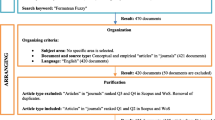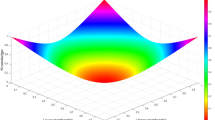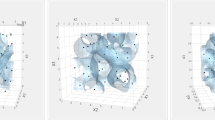Abstract
Fierce competition in the global market forces companies to satisfy all aspects of customers’ needs during the product design stage. Among the customers’ needs, affective needs are difficult to satisfy since understanding the affective needs of customers is a challenging task. Therefore, Kansei Engineering (KE), which is capable of transforming the affective needs of customers into product design form elements, has been widely used in literature. In KE, there are two types of systems: Forward KE and Backward KE. In the forward KE, Kansei words are inputs of the system and product design form elements are outputs of the system, while the product design form elements are inputs and Kansei words are outputs of the system in the backward KE. In this study, fuzzy linguistic summarization is proposed to extract fuzzy rules in the form of “if–then” rules that associate customers’ affective needs into product design form elements for both backward and forward KE. The brute force approach and genetic algorithm (GA) are used to obtain the most useful linguistic summaries supported by enough data, efficiently. Furthermore, fuzzy association rule mining using the Apriori algorithm is employed to compare the obtained results of fuzzy linguistic summarization. A case study is conducted on cradle design to illustrate the applicability of the proposed fuzzy linguistic summarization and the fuzzy association rule mining. Even though the brute force approach is the best option to generate linguistic summaries, it could not be efficiently used in the design of complex products since its time complexity is exponential; and therefore, GA could be used to generate linguistic summaries in an efficient way when time complexity of the approaches is compared. The results show that fuzzy linguistic summarization is an effective and powerful tool to capture the affective needs of customers.













Similar content being viewed by others
References
Agrawal R, Imieliński T, Swami A (1993) Mining association rules between sets of items in large databases. In: Proceedings of the 1993 ACM SIGMOD International Conference on management of data, 1993. pp 207–216
Akay D, Kurt M (2009) A neuro-fuzzy based approach to affective design. Int J Adv Manuf Tech 40:425–437. https://doi.org/10.1007/s00170-007-1367-3
Altintop T, Yager RR, Akay D, Boran FE, Ünal M (2017) Fuzzy linguistic summarization with genetic algorithm: an application with operational and financial healthcare data. Int J Uncertain Fuzziness Knowl-Based Syst 25:599–620
Bahn S, Lee C, Nam CS, Yun MH (2009) Incorporating affective customer needs for luxuriousness into product design attributes. Hum Factor Ergon Man 19:105–127. https://doi.org/10.1002/Hfm.20140
Boran FE, Akay D (2014) A generic method for the evaluation of interval type-2 fuzzy linguistic summaries. IEEE Trans Cybernetics 44:1632–1645. https://doi.org/10.1109/Tcyb.2013.2291272
Boran FE, Akay D, Yager RR (2014a) A probabilistic framework for interval type-2 fuzzy linguistic summarization. IEEE Tarns Fuzzy Syst 22:1640–1653. https://doi.org/10.1109/Tfuzz.2014.2302492
Boran FE, Efe B, Akay D, Henson B (2014b) Understanding customers’ affective needs with linguistic summarization. In: KEER2014. Proceedings of the 5th Kanesi Engineering and Emotion Research; International Conference; Linköping; Sweden; June 11–13, 2014b. Linköping University Electronic Press, pp 1235–1245
Boran FE, Akay D, Yager RR (2016) An overview of methods for linguistic summarization with fuzzy sets. Expert Syst Appl 61:356–377. https://doi.org/10.1016/j.eswa.2016.05.044
Castillo-Ortega R, Marin N, Sánchez D, Tettamanzi AGB (2011) Linguistic summarization of time series data using genetic algorithms. In: Paper presented at the European Society for fuzzy logic and technology, Aix-Les-Bains/France
Chan KY, Kwong CK, Dillon TS, Fung KY (2011) An intelligent fuzzy regression approach for affective product design that captures nonlinearity and fuzziness. J Eng Design 22:523–542. https://doi.org/10.1080/09544820903550924
Chang HC, Lai HH, Chang YM (2007) A measurement scale for evaluating the attractiveness of a passenger car form aimed at young consumers. Int J Ind Ergon 37:21–30. https://doi.org/10.1016/j.ergon.2006.09.014
Chen M-C, Hsu C-L, Chang K-C, Chou M-C (2015a) Applying Kansei engineering to design logistics services—a case of home delivery service. Int J Ind Ergon 48:46–59
Chen M-C, Chang K-C, Hsu C-L, Xiao J-H (2015b) Applying a Kansei engineering-based logistics service design approach to developing international express services. Int J Phys Distrib Log Manag 45:618–646
Cordón O, Gomide F, Herrera F, Hoffmann F, Magdalena L (2004) Ten years of genetic fuzzy systems: current framework and new trends. Fuzzy Sets Syst 141:5–31. https://doi.org/10.1016/s0165-0114(03)00111-8
Dahan E, Srinivasan V (2000) The predictive power of internet-based product concept testing using visual depiction and animation. J Prod Innovat Manag 17:99–109. https://doi.org/10.1016/S0737-6782(99)00029-6
Delgado M, Sanchez D, Vila MA (2000) Fuzzy cardinality based evaluation of quantified sentences. Int J Approx Reason 23:23–66. https://doi.org/10.1016/S0888-613x(99)00031-6
Delgado M, Marín N, Sánchez D, Vila M-A (2003) Fuzzy association rules: general model and applications. IEEE T Fuzzy Syst 11:214–225
Demirbilek O, Sener B (2003) Product design, semantics and emotional response. Ergonomics 46:1346–1360. https://doi.org/10.1080/00140130310001610874
Diego-Mas JA, Alcaide-Marzal J (2016) Single users’ affective responses models for product form design. Int J Ind Ergon 53:102–114. https://doi.org/10.1016/j.ergon.2015.11.005
Donis-Díaz CA, Muro AG, Bello-Pérez R, Morales EV (2014) A hybrid model of genetic algorithm with local search to discover linguistic data summaries from creep data. Expert Syst Appl 41:2035–2042. https://doi.org/10.1016/j.eswa.2013.09.002
Fazzolari M, Alcala R, Nojima Y, Ishibuchi H, Herrera F (2013) A review of the application of multiobjective evolutionary fuzzy systems: current status and further directions. In: Paper presented at the Ieee Transactions on Fuzzy Systems
Goldberg DE (1989) Genetic algorithms in search, optimization and machine learning. Addison-Wesley Longman Publishing Co. Inc
Goldberg DE, Holland JH (1988) Genetic algorithms and machine learning. Mach Learn 3:95–99
Grand-View-Research (2018) Kids furniture market size, share & trends analysis report by product, by raw material (Wood, Polymer, Metal), By Application (Commercial, Household), By Region, And Segment Forecasts, 2019–2025. https://www.grandviewresearch.com/industry-analysis/kids-furniture-market. Accessed 9 Feb 2021
Guo F, Liu WL, Cao Y, Liu FT, Li ML (2016) Optimization design of a webpage based on Kansei engineering. Hum Fact Ergon Manuf Serv Ind 26:110–126
Guo F, Hu M, Duffy VG, Shao H, Ren Z (2021) Kansei evaluation for group of users: a data-driven approach using dominance-based rough sets. Adv Eng Inform 47:101241
Han SH, Hwan Yun M, Kim K-J, Kwahk J (2000) Evaluation of product usability: development and validation of usability dimensions and design elements based on empirical models. Int J Ind Ergon 26:477–488
Han SH, Yun MH, Kwahk J, Hong SW (2001) Usability of consumer electronic products. Int J Ind Ergon 28:143–151. https://doi.org/10.1016/S0169-8141(01)00025-7
Han SH, Kim KJ, Yun MH, Hong SW, Kim J (2004) Identifying mobile phone design features critical to user satisfaction. Hum Factor Ergon Man 14:15–29. https://doi.org/10.1002/Hfm.10051
Hartono M (2020) The modified Kansei Engineering-based application for sustainable service design. Int J Ind Ergon 79:102985
Herrera F (2008) Genetic fuzzy systems: taxonomy, current research trends and prospects. Evol Intell 1:27–46. https://doi.org/10.1007/s12065-007-0001-5
Herrera F, Magdalena L (1997) Genetic fuzzy systems. Tatra Mt Math Publ 13:93–121
Hesketh T, Pryor R, Hesketh B (1988) An application of a computerized fuzzy graphic rating scale to the psychological measurement of individual differences. Int J Man Mach Stud 29:21–35
Hong T-P, Kuo C-S, Chi S-C (1999) Mining association rules from quantitative data. Intell Data Anal 3:363–376
Hong SW, Han SH, Kim KJ (2008) Optimal balancing of multiple affective satisfaction dimensions: A case study on mobile phones. Int J Ind Ergon 38:272–279. https://doi.org/10.1016/j.ergon.2007.09.002
Hsiao SW (1994) Fuzzy set-theory applied to car style design. Int J Vehicle Des 15:255–278
Hsiao S-W, Huang H-C (2002) A neural network based approach for product form design. Des Stud 23:67–84
Hsiao SW, Tsai HC (2005) Applying a hybrid approach based on fuzzy neural network and genetic algorithm to product form design. Int J Ind Ergon 35:411–428. https://doi.org/10.1016/j.ergon.2004.10.007
Hsiao Y-H, Chen M-C, Liao W-C (2017) Logistics service design for cross-border E-commerce using Kansei engineering with text-mining-based online content analysis. Telematics Inform 34:284–302
Huicong H, Wen-Feng L (2020) Design specification representation for intelligent product appearance design. In: E3S Web of Conferences, 2020. E3S Web of Conferences, p 02004
Jiao JX, Zhang YY, Helander M (2006) A Kansei mining system for affective design. Expert Syst Appl 30:658–673. https://doi.org/10.1016/j.eswa.2005.07.020
Kacprzyk J, Wilbik A, Zadrozny S (2006) Using a genetic algorithm to derive a linguistic summary of trends in numerical time series. In: Paper presented at the International Symposium on evolving fuzzy systems, Ambleside/United Kingdom,
Kang X, Porter CS, Bohemia E (2020) Using the fuzzy weighted association rule mining approach to develop a customer satisfaction product form. J Intell Fuzzy Syst 38:4343–4357. https://doi.org/10.3233/JIFS-190957
Kapkin E, Joines S (2018) An investigation into the relationship between product form and perceived meanings. Int J Ind Ergon 67:259–273. https://doi.org/10.1016/j.ergon.2018.05.009
Khalid HM, Helander MG (2004) A framework for affective customer needs in product design. Theor Issues Ergon Sci 5:27–42
Kim H-S, Cho S-B (2000) Application of Interactive Genetic Algorithm to Fashion Design Eng Appl Artif Intel 13:635–644
Kwon KS (1999) Human sensibility ergonomics in product design. Int J Cogn Ergon 3:51–62
Kwong CK, Jiang HM, Luo XG (2016) AI-based methodology of integrating affective design, engineering, and marketing for defining design specifications of new products. Eng Appl Artif Intel 47:49–60. https://doi.org/10.1016/j.engappai.2015.04.001
Lai HH, Lin YC, Yeh CH (2005) Form design of product image using grey relational analysis and neural network models. Comput Oper Res 32:2689–2711. https://doi.org/10.1016/j.cor.2004.03.021
Lai HH, Lin YC, Yeh CH, Wei CH (2006) User-oriented design for the optimal combination on product design. Int J Prod Econ 100:253–267. https://doi.org/10.1016/j.ijpe.2004.11.005
Li Z, Tian Z, Wang J, Wang W, Huang G (2018) Dynamic mapping of design elements and affective responses: a machine learning based method for affective design. J Eng Design 29:358–380
Lin YC, Lai HH, Yeh CH (2007) Consumer-oriented product form design based on fuzzy logic: a case study of mobile phones. Int J Ind Ergon 37:531–543. https://doi.org/10.1016/j.ergon.2007.03.003
Lo CH, Ko YC, Hsiao SW (2015) A study that applies aesthetic theory and genetic algorithms to product form optimization. Adv Eng Inf 29:662–679. https://doi.org/10.1016/j.aei.2015.06.004
Mele M, Campana G (2018) Prediction of Kansei engineering features for bottle design by a knowledge based system. Int J Interact Des Manuf (IJIDeM) 12:1201–1210
Mendel JM (1995) Fuzzy logic systems for engineering: a tutorial. Proc IEEE 83:345–377
Nagamachi M (1995) Kansei engineering: a new ergonomic consumer-oriented technology for product development. Int J Ind Ergon 15:3–11
Nagamachi M (1999) Kansei engineering and its applications in automotive design. SAE Trans 108:2275–2282
Nazari-Shirkouhi S, Keramati A (2017) Modeling customer satisfaction with new product design using a flexible fuzzy regression-data envelopment analysis algorithm. Appl Math Model 50:755–771. https://doi.org/10.1016/j.apm.2017.01.020
Özdoğan İ, Boran FE, Akay D (2021) A possibilistic approach for interval type-2 fuzzy linguistic summarization of time series. Artif Intell Rev. https://doi.org/10.1007/s10462-020-09945-z
Oztekin A, Iseri A, Zaim S, Nikov A (2013) A Taguchi-based kansei engineering study of mobile phones at product design stage. Prod Plan Control 24:465–474. https://doi.org/10.1080/09537287.2011.633575
Pawar PM, Ganguli R (2011) Genetic fuzzy system. In: Pawar PM, Ganguli R (eds) Structural health monitoring using genetic fuzzy systems. Springer-Verlag, London, pp 25–40. https://doi.org/10.1007/978-0-85729-907-9_2
Poirson E, Depince P, Petiot JF (2007) User-centered design by genetic algorithms: application to brass musical instrument optimization. Eng Appl Artif Intell 20:511–518. https://doi.org/10.1016/j.engappai.2006.09.002
Restuputri DP, Masudin I, Sari CP (2020) Customers perception on logistics service quality using Kansei engineering: empirical evidence from Indonesian logistics providers. Cogent Bus Manag 7:1751021
Shi FQ, Sun SQ, Xu J (2012) Employing rough sets and association rule mining in KANSEI knowledge extraction. Inf Sc 196:118–128. https://doi.org/10.1016/j.ins.2012.02.006
Shieh MD, Yang CC (2008) Classification model for product form design using fuzzy support vector machines. Comput Ind Eng 55:150–164
Shieh MD, Li YF, Yang CC (2018) Comparison of multi-objective evolutionary algorithms in hybrid Kansei engineering system for product form design. Adv Eng Inf 36:31–42. https://doi.org/10.1016/j.aei.2018.02.002
Transparency-Market-Research (2016) Baby cribs and cots market-global industry analysis, size, share, growth, trends, and forecast 2017-2025. https://www.transparencymarketresearch.com/baby-cribs-cots-market.html. Accessed 9 Feb 2021
Tsai HC, Hsiao SW, Hung FK (2006) An image evaluation approach for parameter-based product form and color design. Comput Aided Design 38:157–171. https://doi.org/10.1016/j.cad.2005.10.001
Wang KC (2011) A hybrid Kansei engineering design expert system based on grey system theory and support vector regression. Expert Syst Appl 38:8738–8750. https://doi.org/10.1016/j.eswa.2011.01.083
Wang W, Li Z, Liu L, Tian Z, Tsui E (2018) Mining of affective responses and affective intentions of products from unstructured text. J Eng Des 29:404–429
Wang WM, Wang J, Li Z, Tian Z, Tsui E (2019) Multiple affective attribute classification of online customer product reviews: a heuristic deep learning method for supporting Kansei engineering. Eng Appl Artif Intell 85:33–45
Wodehouse A, Vasantha G, Corney J, Jagadeesan A, MacLachlan R (2018) Realising the affective potential of patents: a new model of database interpretation for user-centred design. J Eng Des 29:484–511
Wu DR, Mendel JM (2011) Linguistic Summarization using IF-THEN rules and interval type-2 fuzzy sets. IEEE T Fuzzy Syst 19:136–151. https://doi.org/10.1109/Tfuzz.2010.2088128
Yager RR (1982) A new approach to the summarization of data. Inf Sci 28:69–86. https://doi.org/10.1016/0020-0255(82)90033-0
Yager RR (1991) On linguistic summaries of data. In: Knowledge discovery in databases, pp 347–363
Yager RR (1995) Linguistic summaries as a tool for database discovery. In: Proc. of the FUZZ-IEEE/IFES, 1995. pp 79–84
Yager RR (1996) Database discovery using fuzzy sets. Int J Intell Syst 11:691–712. https://doi.org/10.1002/(Sici)1098-111x(199609)11:9%3c691::Aid-Int7%3e3.0.Co;2-F
Yanagisawa H, Fukuda S (2005) interactive reduct evolutional computation for aesthetic design. J Comput Inf Sci Eng 5:1–7. https://doi.org/10.1115/1.1846055
Yang X (2014) Genetic algorithms. In: Yang X-S (ed) Nature-inspired optimization algorithms. Elsevier, Amsterdam
Yang CC (2011a) Constructing a hybrid Kansei engineering system based on multiple affective responses: Application to product form design. Comput Ind Eng 60:760–768. https://doi.org/10.1016/j.cie.2011.01.011
Yang CC (2011b) A classification-based Kansei engineering system for modeling consumers’ affective responses and analyzing product form features. Expert Syst Appl 38:11382–11393. https://doi.org/10.1016/j.eswa.2011.03.008
Yang CC, Shieh MD (2010) A support vector regression based prediction model of affective responses for product form design. Comput Ind Eng 59:682–689. https://doi.org/10.1016/j.cie.2010.07.019
Yeh C-T, Chen M-C (2018) Applying Kansei Engineering and data mining to design door-to-door delivery service. Comput Ind Eng 120:401–417
Zadeh LA (1965) Information and control. Fuzzy Sets 8:338–353. https://doi.org/10.1016/S0019-9958(65)90241-X
Acknowledgements
This work was supported by the Scientific and Technological Research Council of Turkey under Grant TUBITAK: TEYDEB-1505, 5170065. The authors are very grateful to three anonymous reviewers for their constructive suggestions in improving our manuscript.
Author information
Authors and Affiliations
Corresponding author
Additional information
Publisher's Note
Springer Nature remains neutral with regard to jurisdictional claims in published maps and institutional affiliations.
Rights and permissions
About this article
Cite this article
Akgül, E., Delice, Y., Aydoğan, E.K. et al. An application of fuzzy linguistic summarization and fuzzy association rule mining to Kansei Engineering: a case study on cradle design. J Ambient Intell Human Comput 13, 2533–2563 (2022). https://doi.org/10.1007/s12652-021-03292-9
Received:
Accepted:
Published:
Issue Date:
DOI: https://doi.org/10.1007/s12652-021-03292-9




